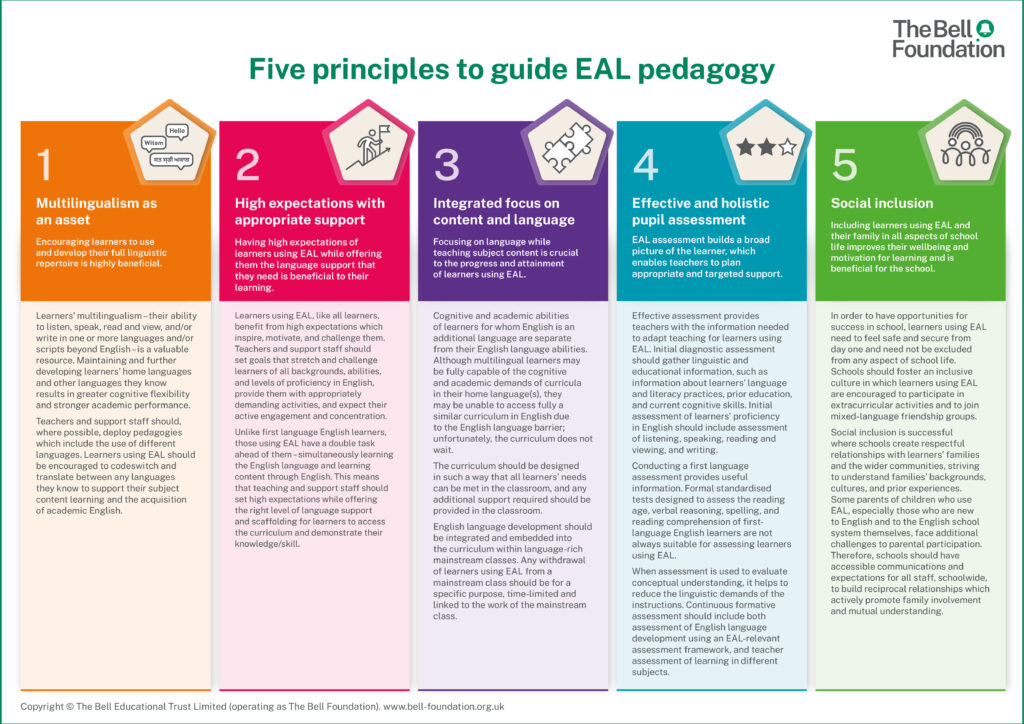Effective Teaching of EAL Learners
The context for EAL pedagogy
EAL learners have a dual task at school: to learn English (language) and to learn through English. For this reason, EAL teaching aims to teach English using the mainstream curriculum as the context. Specific teaching strategies and resources are therefore necessary to make the language of the curriculum accessible to learners who use EAL.
Five principles to guide EAL pedagogy
The five principles below are intended to guide schools as they develop and embed effective provision for learners using EAL. Schools which orient their support based on these Principles – which take account of what is unique to this group of learners, e.g., multilingualism, and what they share in common with all other learners, e.g., the need for high expectations – will allow their learners to thrive both academically and emotionally.
You may be interested to know that the Principles inform and underpin all of our Great Ideas as well as the creation of our EAL teaching resources. They are also used as an organising principle in our Classroom Guidance and Strategies to Support EAL Learners, which work alongside our EAL Assessment Framework.
You can download the Principles as posters below, to share online or print and display in your school.
Principle 1 
Multilingualism as an asset
Encouraging learners to use and develop their full linguistic repertoire is highly beneficial.
Learners’ multilingualism – their ability to listen, speak, read and view, and/or write in one or more languages and/or scripts beyond English – is a valuable resource. Maintaining and further developing learners’ home languages and other languages they know results in greater cognitive flexibility and stronger academic performance. Teachers and support staff should, where possible, deploy pedagogies which include the use of different languages. Learners using EAL should be encouraged to codeswitch and translate between any languages they know to support their subject content learning and the acquisition of academic English.
Principle 2 
High expectations with appropriate support
Having high expectations of learners using EAL while offering them the language support that they need is beneficial to their learning.
Learners using EAL, like all learners, benefit from high expectations which inspire, motivate, and challenge them. Teachers and support staff should set goals that stretch and challenge learners of all backgrounds, abilities, and levels of proficiency in English, provide them with appropriately demanding activities, and expect their active engagement and concentration.
Unlike first language English learners, those using EAL have a double task ahead of them – simultaneously learning the English language and learning content through English. This means that teaching and support staff should set high expectations, while offering the right level of language support and scaffolding for learners to access the curriculum and demonstrate their knowledge/skill.
Principle 3 
Integrated focus on content and language
Focusing on language while teaching subject content is crucial to the progress and attainment of learners using EAL.
Cognitive and academic abilities of learners for whom English is an additional language are separate from their English language abilities. Although multilingual learners may be fully capable of the cognitive and academic demands of curricula in their home language(s), they may be unable to access fully a similar curriculum in English due to the English language barrier; alas, the curriculum does not wait.
The curriculum should be designed in such a way that all learners’ needs can be met in the classroom, and any additional support required should be provided in the classroom. English language development should be integrated and embedded into the curriculum within language-rich mainstream classes. Any withdrawal of learners using EAL from a mainstream class should be for a specific purpose, time-limited and linked to the work of the mainstream class.
Principle 4
Effective and holistic pupil assessment
EAL assessment builds a broad picture of the learner, which enables teachers to plan appropriate and targeted support.
Effective assessment provides teachers with the information needed to adapt teaching for EAL learners. Initial diagnostic assessment should gather linguistic and educational information, such as information about learners’ language and literacy practices, prior education, and current cognitive skills. Initial assessment of learners’ proficiency in English should include assessment of listening, speaking, reading and viewing, and writing.
Conducting a first language assessment provides useful information. Formal standardised tests designed to assess the reading age, verbal reasoning, spelling, and reading comprehension of first-language English learners are not always suitable for assessing learners using EAL.
When assessment is used to evaluate conceptual understanding, it helps to reduce the linguistic demands of the instructions. Continuous formative assessment should include both assessment of English language development using an EAL-relevant assessment framework, and teacher assessment of learning in different subjects.
Principle 5 
Social inclusion
Including learners using EAL and their family in all aspects of school life improves their wellbeing and motivation for learning and is beneficial for the school.
In order to have opportunities for success in school, learners using EAL need to feel safe and secure from day one and need not be excluded from any aspect of school life. Schools should foster an inclusive culture in which learners using EAL are encouraged to participate in extracurricular activities and to join mixed-language friendship groups.
Social inclusion is successful where schools create respectful relationships with learners’ families and the wider communities, striving to understand families’ backgrounds, cultures, and prior experiences. Some parents of children who use EAL, especially those who are new to English and to the English school system themselves, face additional challenges to parental participation. Therefore, schools should have accessible communications and expectations for all staff, schoolwide, to build reciprocal relationships which actively promote family involvement and mutual understanding.

